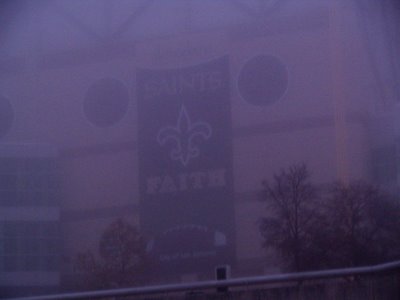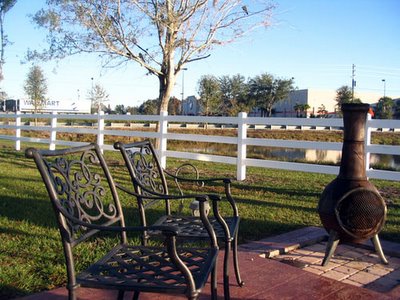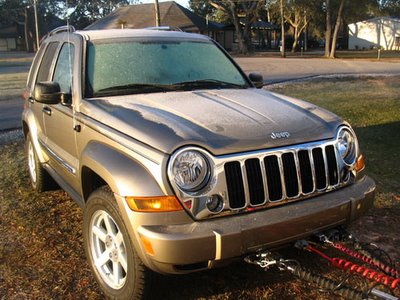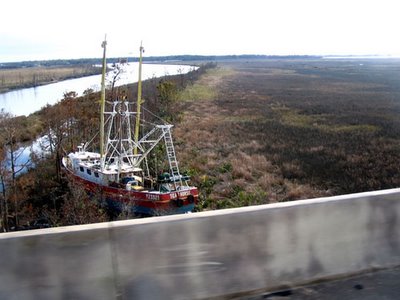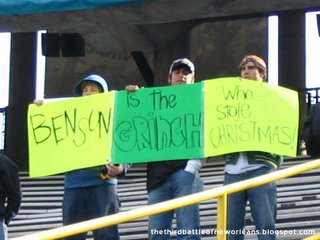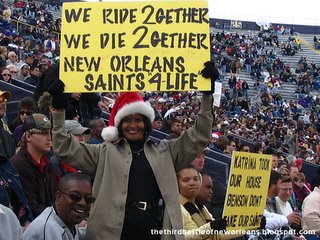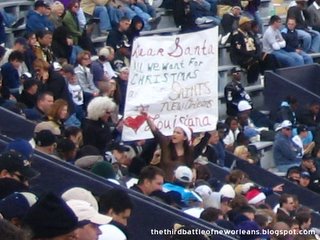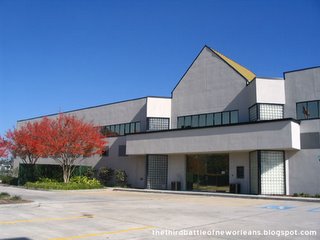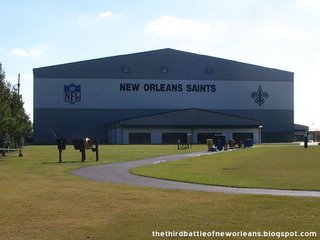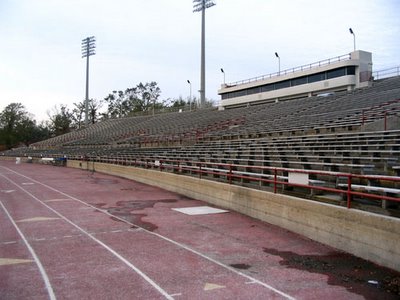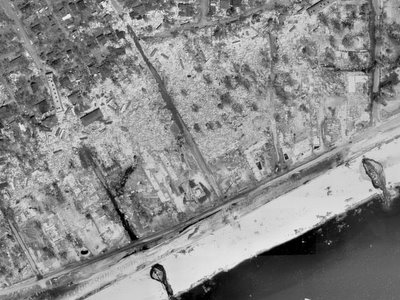Following is a great piece written about two weeks ago by a friend who lives in Mid City. This is about as honest an assessment of flood-effected post-KTMB New Orleans life for as he describes himself (although his house did get flooded) "one of the lucky ones."
Follow his hurricane story from initial evacuation, to seeing pictures of his house post-KTMB for the first time, to getting into New Orleans the first time post-KTMB, to accepting the new unfortunate realities . . . .
Sun, 04 Dec 2005
Three Months Later....It's now three months after the storm and it's hard to believe that this much time has passed already. First things first:
Things are not okay in New Orleans.As a recent Time Magazine cover put it,
"New Orleans Today: It's Worse Than You Think". The best one could say is that this will be a very slow rebuilding process. I feel I have to say this front and center because when we talk to friends and family outside of New Orleans, we're finding that people think things are getting back to normal here.
We wish.
The TV news media have moved on, occasionally broadcasting scenes of Bourbon Street reverie as signs that things are just peachy. Bourbon Street is a minuscule slice of New Orleans as a whole. Don't get me wrong, I'm pleased the Quarter is relatively healthy. But the reality is that 75% of the entire city flooded. It's hard to make the magnitude of that real to people. Pictures do not do it justice. You could try the numbers. For example, out of a city of 450,000, only around 65,000 sleep here at night now. Over 200,000 homes in Orleans Parish were flooded. But even the numbers don't really tell the story. You have to see it.
And it's hard to say which view is more dramatic. They daytime view of mile after mile of empty, gutted homes with their attendant debris piles out front and "dirty bathtub ring" water line. Or the
view at night, with so much of the city in the dark.
Coming back home was a whirlwind. Everything was a crisis and it was impossible to choose between various priorities. We were dealing with insurance companies, FEMA, our jobs, finding a place to live, and trying to gut and clean the house. That last bit turned out to be rather therapeutic, at least for a while. After spending hours on hold on cell phones that barely work just so you could talk to people who couldn't help and couldn't answer your questions, it does feel good to smash sheetrock with a five pound sledgehammer. You don't even think about the fact that you own the moldy, damp sheetrock you're smashing to bits.
There was and is mold everywhere. This is the inevitable result of stinky, salty, poo-filled water sitting in your house for two to three weeks. And then two weeks more before you're allowed to get in and "remediate" the "water damage." At first you're careful, wearing your mask or respirator. But after a while, it's just plain irritating and there's spores in the open air anyway mixing with the sheetrock dust and dried up muck. We've experienced the "Katrina cough", undoubtedly exacerbated by a constant state of stress and general lack of sleep.
In post-Katrina New Orleans, the new greeting is, "how'd ya make out?" That question is almost always followed by a matter of fact description that goes something like this: "Oh, we had about 6 feet of water and the roof blew off part of the back of the house and the neighbor's car is on my fence. But we're doin allright." And it's true. Jennifer and I feel pretty lucky to only have 1-2 feet in the house. I have friends and family who had 1-2 feet of water in their attics. We were able to evacuate with our photos albums, pets, Jennifer's wedding dress, and a fair amount of clothes. Some of our furniture was salvageable. That's the new definition of lucky. You don't have to drive very far to see the definition of unlucky: Lakeview, New Orleans East, much of Gentilly. There's almost no signs of life at all in the East. And then there's the holes in the roofs and attic vents. The hand scrawled pleas for water and for rescue. And there are the bright orange X's spray painted on homes. The first time you see "1 DB" with a line through it indicating that a dead body was found and later removed, you don't forget it.
So why are we still here?
We are surrounded by utter devastation, miles of trash, debris and emptiness. On nearly every statistical indicator, pre-storm Louisiana is ranked at or near the bottom. We had the worst public school system to be found in the US. Murder occurred every day. And clearly there was abject poverty everywhere (don't look in the mirror, you other American cities). By nearly every measure, quality of life here before Katrina should have been miserable.
It was anything but. We loved our home and we are far from unique. We don't know if we'll ultimately be able to stay, but we very much want to. New Orleans is sticky in more ways than one. People who were born here, stay here. And people who move here, fall in love and stay here too.
I desperately miss walking Callie around Bayou St John. Ours was a real neighborhood where we truly got to know our neighbors. Just the other day, one of my neighbors called just to see how we were doing. This from a man with some significant health problems who had to be evacuated from a hospital after the storm. Our groceries and restaurants were all within an easy walk. Our Mid City neighborhood is filled with the architectural delights that can only be found in such abundance in New Orleans. As
this USA Today(!) article reveals, our neighborhood was incredibly diverse.
I won't pretend it was a Utopia. There was occasional petty crime and clearly there was some drug dealing going on. It was frustrating to clean the litter off of our little front lawn every day after work. But it was still home. Streetcars had returned to Canal after a 40 year hiatus adding a new vibrancy to the area surrounding Canal at Carrollton. The homeowners were gaining ground and pushing out New Orleans' ugly drug culture. It was a neighborhood on the mend and growing. Not like so many other places, of course, where they tear down homes and replace them with heavily fortified mansions. In New Orleans, we don't tear down our homes, we renovate them. It takes longer, but we like our original hardwood floors, 13ft ceilings, working transoms, and Victorian details.
The neighborhoods whose names you've heard on the news are all unique in their own ways. Many are filled with multiple generations of families. I was raised just across the parish line in Metairie, but moved back into the neighborhood of my parents' childhood. My grandmother's house, where my mom grew up, is just a few blocks away. We went there every week as kids and we used to enjoy the family Endymion parade party until she moved out in 1991. My great grandmother had a house around the corner on Scott Street. My grandfather tended bar overnight at the Beachcorner Lounge at the end of Canal Street next to the cemeteries. The majority of my extended family lives in the surrounding area. That's pretty typical.
This is the New Orleans you never saw unless you were the type of tourist to travel off the beaten path. We kept it to ourselves, letting the tourism industry hawk the obvious attractions. We don't talk in a Southern accent or a Cajun accent and we don't call it "the Big Easy". To most ears we sound similar to New Yorkers -- that probably has something to do with the diverse mix of old New Orleans Creole French and later immigrants in the late 19th and early 20th century. The Times Picayune columnist, Chris Rose, recently opined that once you lived in New Orleans for a certain period of time, you were ruined for anywhere else. As we consider the possibility of leaving -- and the intelligent, financially motivated parts of our brains tells us we might have to -- I can understand where Chris is coming from. There's just a thousand little things that would otherwise seem inconsequential that make this place truly special and distinct.
And of course there's the food. Yeah, lots of other cities have great restaurants, but New Orleans has New Orleans restaurants. The city is liberally sprinkled with unknown neighborhood restaurants that are decades old. Eating here is an event, not just a necessary bodily function. And of course there's the music. All you have to do is turn on
WWOZ and hear the tons and tons of unique music we've given to the world. There are some classic songs that I hear that now almost stop me in my tracks and make me want to kick myself for even thinking of leaving this place.
Yet think about it we do, our rational brains at war with our hearts and souls. And truth be told, that was true before the storm as well. While in one sense, it's easy to live in New Orleans, it can be hard to make a living here. So here were are like tens of thousands of others floating in a secondary flood of indecision, futilely waiting for some external wisdom and guidance that deep down we know isn't coming. We're just going to have to take a stab in the dark and hope we're doing The Right Thing.
Recommended Reading:The New Orleans Times Picayune at
NOLA.com has been excellent and well worth reading. Their coverage of just what caused those levees to fail is something I'll write on a little bit later. For a more personal view,
Chris Rose has captured what many of us are feeling.
Anne Rice's column,
"What Does it Mean to Lose New Orleans" gets it right.
Michael Lewis'
Wading Toward Home is a must read as well.
Tom Piazza's book
"Why New Orleans Matters" is forcefully argued, and is excerpted
here in Gambit.
John Barry's
Rising Tide: The Great Mississippi Flood of 1927 and How it Changed America is on my must read ASAP list. He was recently
interviewed in Gambit as well.
John Biguenet's blog for the New York Times excerpted
here in Gambit was interesting as well.

